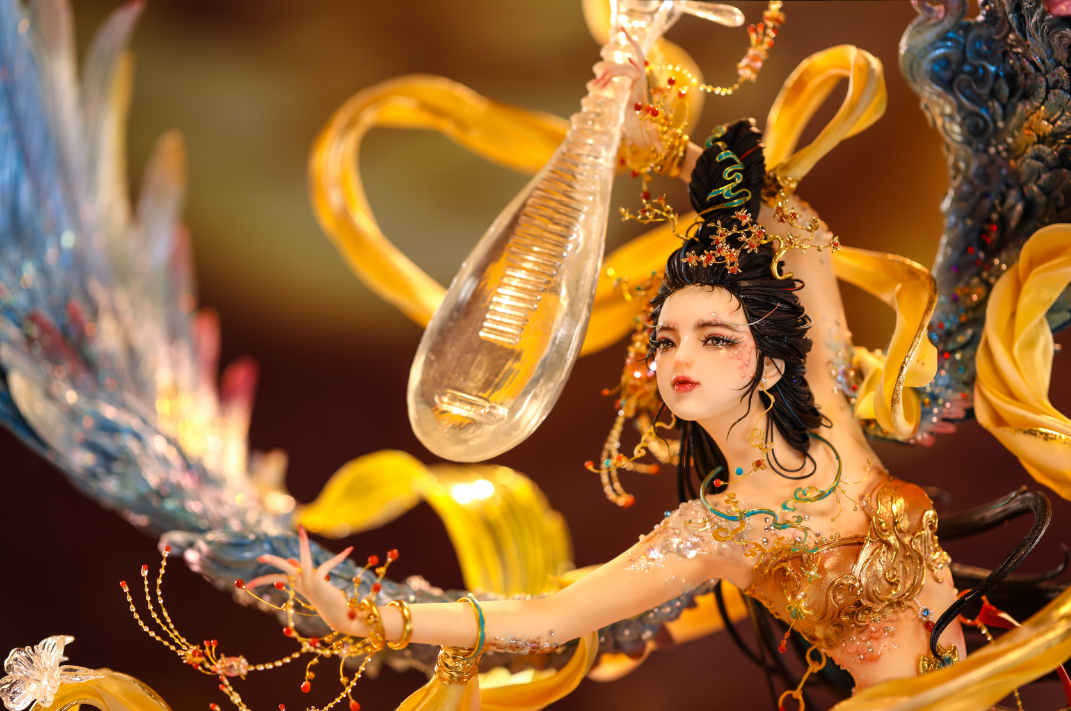Eating Chinese Art

At the 2017 Cake International, a prestigious fondant cake making competition held in Britain, a memorable incident that captivated the judges and fans around the world occurred.
One entry, titled “Lie Drunk in Nepenthic Land,” left everyone in awe with its unimaginable beauty. However, due to a minor technicality, it was nearly disqualified.
This particular entry incorporated the technique of “pulling sugar” (which makes sugar hard) to create the surface of a lake, but to qualify, the cake had to be easily cut with a knife, and it was too hard. Nevertheless, after extensive deliberations by the judging panel, they recognized that the masterpiece couldn’t be overlooked and made an exception by placing it in a different category. Ultimately, the submission secured a bronze award in that category, a testament to the judges’ reluctance to let such artistic brilliance go unrecognized.
However, the story didn’t conclude there.
On that same evening, the creator of this exquisite artwork, Zhou Yi, a young Chinese fondant cake artist, still managed to receive the highest accolade of the entire event with another piece named after Wu Zetian, China’s only female emperor.
For the first time, the highest award of the competition was bestowed on a Chinese individual.

East Meets West
Born in 1983, Zhou Yi is a fondant cake artist from Suzhou. His devout fans on social media call him the “Sugar King.”
Zhou completed his studies on Chinese cuisine cooking with specialization in traditional dough modeling, which honed his skills on modeling and ignited his passion for the aesthetics of food craftsmanship. During a Western dessert competition, he became intrigued with the sugar-pulling technique from foreign countries. Determined to refine his craft, he traveled to France and studied under famous sugar artist Stéphane Klein. During this period, Zhou assimilated a wealth of knowledge of Western pastries. He also explored diverse forms of sugar modeling skills including fondant making.
As Zhou transitioned from traditional Chinese dough sculpting to Western sugarcraft, many wondered what kind of obstacles he would encounter along the way.
“Challenges do not arise from the transition itself,” Zhou explained. “Distinctions between dough and fondant modeling are primarily found in the characteristics of the ingredients employed, which can be mastered when you get used to the new ingredient. The genuine challenge is the art itself.”

Pinnacle of Chinese Artisans
From Zhou Yi’s perspective, there are no shortcuts to master any form of art.
“Everyone is familiar with the story of Leonardo da Vinci painting eggs,” he said. “One can only grasp the intricate details of eggs after painting tens of thousands of them. The same is true for fondant cake modeling.” Through extensive practice, he began to shine in the industry.
Even as Zhou was gaining fame, he was still not content. After a long journey of exploration, he infused his fondant modeling with traditional Chinese craftsmanship. For example, the award-winning piece “Wu Zetian” showcased the remarkable technique of sugar-figurine blowing, an ancient Chinese art and intangible cultural heritage, which left judges from around the world in awe.
“Becoming a skilled fondant modeling craftsman is no easy feat,” Zhou remarked. “You must gain knowledge of plastic surgery, makeup, and hair styling as well as expertise in fashion design, jewelry design, footwear design, furniture design, and landscape design. Understanding perspective, light, and shadow is also essential. Each of these aspects demands significant time and dedication.” Given the steep barriers to entry, few even dare to start the journey to learn such a diverse range of disciplines, all for the sake of creating a sugar figure.
However, the details from this amalgamation of diverse disciplines are precisely what imbues Zhou’s art with unparalleled soul. His works of classical Chinese beauties exhibit exquisite facial expressions, makeup, and garments. The patterns and folds of their clothing and the slight tilt of their adorned headdresses boast vivid details. Even the backdrop screen, the antique display stand, the scroll paintings by the figures’ feet, and the incense burner appear remarkably authentic. These exquisite details were created through an immense reservoir of professional knowledge, dedicated research, and painstaking work. And Zhou doesn’t accept compromise.
In 2019, Zhou and his team won four golden awards at the Cake International for their works “Chang’e” (the Chinese goddess of the moon), “The Legend of the White Snake” (a Chinese folktale about a romance between a man named Xu Xian and a snake spirit named Bai Suzhen), “Butterfly Lovers” (a Chinese legend about a tragic love story of Liang Shanbo and Zhu Yingtai), and “Mermaid.” The judges were again awed by the artistry displayed by the fondant art master. “Through the translucent silk outer garments of the classical beauties, one can see the skin color, which led the judges to mistakenly think they were made of rice paper,” Zhou recalled. “Only when I broke off a piece and asked them to taste it did they believe it was indeed made of sugar. Such skills represent the pinnacle of Chinese artisans.”

Collaborating with Chinese Animation
In addition to the classical beauties series, Zhou has also created works based on popular Chinese animations such as Wukong (a 2017 Chinese fantasy-action-adventure animated film).
“The incorporation of Chinese animation into fondant cake involves infusing fresh elements and delicately dissecting and refining traditional Chinese culture through adaptation to pique people’s interest,” explained Zhou. “Cultivation of such interest makes people develop a deep appreciation for this cultural fusion. By blending traditional heritage with the contemporary preferences of a wider audience, we can create art that meets the demands of our times.”
New technologies are not only lifting the visual appeal to new levels but also enabling a more diverse range of flavors. Through heartfelt creativity, traditional craftsmanship can integrate into modern society and gain new vitality. Zhou has upgraded his fondant ingredients and techniques to continue to narrate the legend of China with beautiful edible figurines.